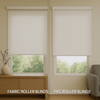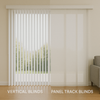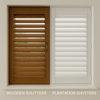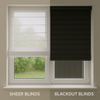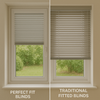Fabric Roller Blinds vs. PVC Roller Blinds: Style, Maintenance, and Cost
- by Mariam Labadze
 Quick Answer
Quick Answer
Fabric roller options offer extensive design variety, softer aesthetics, and luxurious textures ideal for living spaces and bedrooms, with prices typically ranging £40-£120 per window. PVC alternatives provide superior moisture resistance, easy wipe-clean maintenance, and durability perfect for bathrooms and kitchens, usually costing £30-£80 per window. Fabric suits rooms prioritizing style and comfort where moisture isn't a concern, whilst PVC excels in humid environments requiring practical, long-lasting solutions. Both deliver excellent light control and privacy, but material choice significantly impacts maintenance requirements, longevity in specific environments, and overall aesthetic contribution to your interior design scheme.
[toc]
Understanding the Material Differences
-
Moisture resistance – PVC repels water completely; fabric absorbs moisture and can develop mold in humid conditions
-
Aesthetic range – Fabric offers virtually unlimited colors, patterns, and textures; PVC provides limited but practical design options
-
Cleaning requirements – PVC wipes clean instantly; fabric may require gentle cleaning or professional treatment for stains
-
Tactile quality – Fabric feels soft and luxurious; PVC has a more utilitarian, plastic feel
-
Durability factors – PVC resists fading and damage in harsh conditions; fabric may fade with sun exposure over time
-
Environmental impact – Natural fabric options more eco-friendly; PVC production involves more chemicals and processing
-
Installation weight – PVC typically weighs more; fabric rolls lighter and easier to handle
Fabric Options: Style and Sophistication
Fabric materials transform functional window treatments into design elements that enhance interior aesthetics. The material selection spans from sheer voiles creating ethereal atmospheres to heavy blackout weaves providing complete darkness for quality sleep.
Natural fibers like cotton, linen, and blends offer breathability and organic textures that complement traditional and contemporary interiors. These materials soften harsh architectural lines, adding warmth that makes spaces feel inviting and comfortable rather than sterile or cold.
Pattern possibilities with fabric prove virtually limitless. Geometric designs suit modern spaces, floral prints enhance country cottages, textured weaves add depth without overt patterns, and custom printed fabrics allow completely personalized designs matching specific color schemes or themes.
The way fabric filters light creates ambiance impossible to achieve with solid PVC. Semi-translucent fabrics diffuse sunlight into gentle illumination that flatters interiors throughout the day, reducing glare whilst maintaining connection with outdoor views and natural light rhythms.
Layering capabilities make fabric particularly versatile. Many homeowners install sheer fabric options alongside heavier blackout versions, adjusting layers throughout the day to manage light levels precisely. This flexibility accommodates changing needs from morning brightness to evening privacy without compromise.
Premium fabrics introduce luxury textures—silk, velvet, or jacquard weaves—that elevate window treatments from functional necessities to statement pieces. These materials justify their premium costs through visual impact that transforms entire room aesthetics.
PVC Options: Practical Performance
PVC represents engineered efficiency optimized for challenging environments where moisture, temperature fluctuations, and cleaning demands defeat natural materials. The synthetic composition resists water penetration completely, making it ideal for bathrooms, kitchens, and other high-humidity spaces.
Modern PVC has evolved beyond basic white or beige utility. Contemporary options include wood-effect finishes mimicking natural timber grain, metallic sheens creating modern industrial aesthetics, and various solid colors coordinating with diverse design schemes.
The material's inherent durability means it maintains appearance despite exposure to steam, splashes, and temperature variations that would damage fabric alternatives. PVC won't warp, fade quickly, or develop the musty odors that moisture-exposed fabrics acquire over time.
For commercial applications or high-traffic areas in homes, PVC withstands abuse that would quickly deteriorate fabric. The tough surface resists scratches, impacts, and the wear from constant operation that eventually damages more delicate materials.
Blackout PVC creates complete darkness effectively, blocking light penetration whilst maintaining the material's moisture-resistant properties. This combination suits bathrooms where privacy and humidity resistance both matter, or kitchens where cooking steam presents challenges.
The weight and rigidity of PVC provides smooth rolling operation with minimal flutter or movement from drafts. This stability matters on larger windows where lighter fabrics might billow or shift, affecting both appearance and light control consistency.
Maintenance and Cleaning Requirements
Cleaning ease represents one of PVC's strongest advantages. Wipe surfaces with damp cloths to remove dust, splashes, or cooking residue instantly. The non-porous surface prevents stain absorption, and mild detergent solutions handle stubborn marks without special treatments or professional cleaning.
For particularly dirty PVC, remove the blind entirely and rinse with a hose or shower, allowing it to dry completely before reinstalling. This thorough cleaning—impossible with most fabrics—restores like-new appearance without professional intervention or replacement concerns.
Fabric maintenance demands more careful attention. Regular dusting or vacuuming with brush attachments prevents buildup, but addressing stains requires gentle spot cleaning with appropriate solutions. Harsh chemicals or aggressive scrubbing can damage fibers, fade colors, or create water marks more visible than original stains.
Many fabric options require professional cleaning for comprehensive maintenance, adding ongoing costs beyond initial purchase. However, this infrequent deep cleaning—perhaps every few years—maintains appearance and extends lifespan significantly when performed properly.
Some modern fabrics feature protective treatments reducing stain absorption and easing maintenance. These treated materials bridge the gap between fabric aesthetics and PVC practicality, though they typically cost more than standard untreated alternatives.
Bathroom and kitchen environments quickly reveal material limitations. Fabric in these spaces requires diligent maintenance preventing moisture absorption that leads to mold, mildew, and unpleasant odors. PVC eliminates these concerns entirely, requiring only occasional wiping despite constant humidity exposure.
Room-by-Room Application Guidance
Bathrooms demand PVC or specially treated moisture-resistant fabrics. Standard fabric materials develop problems quickly in steam-filled environments, whilst PVC thrives in conditions that challenge other materials. The easy cleaning proves invaluable where water spots and soap residue accumulate.
Kitchens benefit from PVC's resistance to cooking splashes, grease, and steam. Fabric near hobs or sinks absorbs odors and stains that prove difficult removing completely. However, dining areas within kitchen spaces might accommodate fabric successfully if positioned away from direct cooking zones.
Bedrooms showcase fabric's strengths—luxurious textures, extensive design options, and the soft aesthetic that creates restful atmospheres conducive to sleep. The room's typically low humidity and minimal exposure to stains make fabric practical whilst its beauty enhances the space's primary purpose.
Living rooms and lounges allow fabric to shine through pattern, texture, and color contributing to overall design schemes. These social spaces benefit from fabric's aesthetic versatility, creating ambiance that PVC's utilitarian appearance cannot match.
Home offices suit either material depending on priorities. Fabric creates professional, sophisticated atmospheres whilst managing glare effectively. PVC offers practical maintenance-free operation for busy professionals who lack time for careful cleaning routines.
Children's rooms present competing considerations. Fabric provides softer aesthetics and extensive fun patterns, but PVC's durability and easy cleaning suit rooms where accidents and rough treatment occur regularly. Consider the child's age and room usage patterns when deciding.
Cost Comparison and Value Analysis
Basic fabric options start around £40-£60 per standard window, with premium designer fabrics reaching £100-£150 or more. Custom patterns, luxury materials, or specialized features like thermal backing increase costs substantially beyond baseline prices.
PVC typically costs £30-£80 per window, making it economically attractive for budget-conscious projects or when covering multiple windows. The lower entry price combined with minimal ongoing maintenance costs makes PVC economical over its entire lifespan.
However, pure cost comparison oversimplifies value assessment. Fabric in appropriate locations—bedrooms, living areas—contributes aesthetic value justifying higher prices through enhanced room appearance and ambiance. Installing cheap PVC throughout your home saves money initially but may compromise the comfortable, stylish atmosphere that makes houses feel like homes.
Consider replacement cycles when evaluating costs. PVC in harsh environments like bathrooms might last 10-15 years, whilst fabric in the same location might need replacing after 3-5 years due to moisture damage. This longevity difference significantly affects true cost-per-year calculations.
Professional cleaning costs for fabric add ongoing expenses. If professional cleaning costs £15-£25 per blind every 2-3 years, this accumulates to £75-£125 over a decade—potentially equalizing the initial price advantage of cheaper fabric over PVC alternatives.
Energy efficiency considerations affect long-term value. Thermal-backed fabric options reduce heating and cooling costs through superior insulation compared to basic PVC. These energy savings offset higher initial investments, though calculating exact payback periods requires considering specific climate conditions and energy prices.
Aesthetic Integration with Interior Design
Fabric integrates seamlessly into virtually any design scheme through its extensive variety. Find exact color matches, complementary patterns, or contrasting textures that fulfill specific design visions. This flexibility makes fabric the default choice for design-conscious homeowners prioritizing aesthetics.
The material's texture adds depth and interest even in solid colors. Light plays across fabric surfaces differently throughout the day, creating subtle visual changes that maintain interest. This organic quality makes spaces feel alive and dynamic rather than static.
PVC's aesthetic limitations require realistic acknowledgment. Whilst modern options improve significantly over early utilitarian versions, the material still appears practical rather than beautiful. This works perfectly in utility spaces but feels lacking in rooms where aesthetics matter tremendously.
Strategic PVC use in appropriate locations allows budget allocation toward premium fabric in showcase spaces. Install PVC in bathrooms and utility areas, directing savings toward beautiful fabric treatments in living rooms and bedrooms where visual impact matters most.
Consider the cumulative effect throughout your home. Consistent material choices create cohesive flow, whilst mixing materials room-by-room can feel disjointed unless done thoughtfully. Using similar colors or operating mechanisms across different materials maintains visual harmony despite material variations.
Environmental and Health Considerations
Natural fabric options appeal to environmentally conscious homeowners. Organic cotton, linen, bamboo, and other sustainable materials offer eco-friendly alternatives that minimize environmental impact whilst providing beautiful, functional window treatments.
PVC production involves chemicals and processes with greater environmental impact than natural fiber cultivation. However, PVC's exceptional durability means infrequent replacement reduces long-term waste. A PVC treatment lasting 15 years in a challenging environment may prove more sustainable than fabric requiring replacement every few years.
Indoor air quality concerns favor untreated natural fabrics over PVC, which can off-gas volatile organic compounds, particularly when new. However, reputable manufacturers now produce low-VOC or VOC-free PVC options addressing these health concerns without sacrificing material benefits.
Disposal considerations matter at end-of-life. Natural fabrics biodegrade or compost, whilst PVC persists in landfills indefinitely. Some manufacturers now offer recycling programs accepting old PVC treatments, though availability varies regionally.
Making Your Final Decision
Match materials to specific room requirements rather than choosing one universally. PVC excels where moisture, durability, and easy maintenance matter most. Fabric shines in spaces where aesthetics, comfort, and design flexibility take priority.
Honest assessment of your maintenance commitment guides appropriate choices. If you'll diligently clean and care for fabric, it rewards that effort with beauty and comfort. If you need set-and-forget solutions requiring minimal attention, PVC delivers reliable performance without demanding constant care.
Budget allocation should prioritize spending where impact matters most. Invest in quality fabric for rooms where you spend significant time and appearance affects daily enjoyment. Use practical PVC where function trumps form and savings support better choices elsewhere.
At 1 Click Blinds, both fabric and PVC options deliver quality performance suited to UK homes. Understanding your specific needs, room characteristics, and personal priorities ensures you select materials that enhance your spaces practically and aesthetically for years to come.

